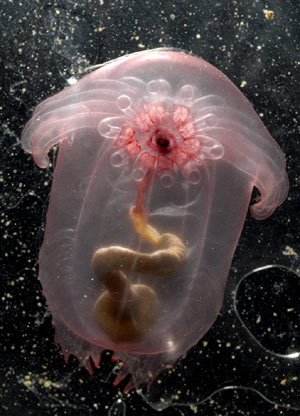November 2009
Go here if you'd like to read this issue on our website.
An email extension of the Pure Water Gazette.
In this issue of the Occasional you'll hear about a dweller of the deep named Enypniastes and learn where fog harvesting is an important source of water. You'll learn that rainwater is safe to drink and that it's dangerous to live near a volcano or the Los Alamos National Laboratory. Learn about World Toilet Day, a revolutionary new nano tube water treatment device, and Ice XV Hear how much water bodybuilders and non-bodybuilders should drink. Learn the symptoms of over-consumption of water and find out what water contaminant comes from rocket fuel. Learn how many times a train loaded with a year's worth of cow manure will go around the earth and many other startling facts about animal dung in water supplies. And, as always, much, much more. The Occasional is overseen and edited by Pure Water Gazette editor in chief Hardly Waite.
Water News from Around the World
While you weren't paying attention, a lot of important things happened. Follow the links if you don't want to remain in the darkness.
In a unique human study, an Australian university has concluded that untreated rainwater is safe to drink.
The New York Times reported that in spite of massive spending for upgrades to sewer systems, a "deluge of sewage" is overwhelming US waterways.
More
than 5,000 new creatures have recently been discovered in deep ocean
waters,"the least explored environment on Earth." It is estimated
that 1,000,000 more species remain unknown.

| Enypniastes, a sea cucumber that lives deep, deep in the Gulf of Mexico. |
How Much Water Should You Drink?
Introduction by Pure Water Gazette Editor Hardly Waite.
The article below, from an extensive bodybuilding website, says several things that need to be said and repeated, since much of what is usually said and repeated about human water consumption requirements is pure nonsense.
The 8-glasses-per-day slogan has been mindlessly repeated for decades by physicians, nutritionists, diet gurus, mothers, grannies, teachers, and others who should know better. Who knows where it originated. You would think there was an Eleventh Commandment that says, "Thou shalt drink eight eight-ounce glasses of water per day."
Does a slender woman who works in an air conditioned office and eats salads and fruits need the same 8-glass water ration as the beefy construction worker who spends the day in the sun and wolfs down potato chips and salami sandwiches?
Do both the secretary and the construction worker need the same amount of water on Tuesday and Friday?
Since we sweat more some days than others, and we pee more some days than others, and we eat more some days than others, and we sleep more some days than others, and we work harder some days than others, it would seem obvious that we need more water some days than others. And it should be equally obvious that that people in different geographical regions, under different socioeconomic circumstances, and in varying states of physical and mental health don't all need exactly eight eight-ounce glasses of water per day.
So how do you decide how much water you should drink? The Pure Water Gazette endorses the radical view that plain water should be your drink of preference and that you should get a drink when you feel thirsty and drink no water if you aren't thirsty.
How Much Water Do You Really Need?
by Dr. Mauro Di Pasquale
Almost everyone agrees that water is good for you and that the biggest problem with water intake is that you don't drink enough. We have all had it drummed into us that we need to drink at least eight glasses of water a day. That it's important to drink water before and during exercise.
That coffee and tea don't count because caffeine can dehydrate our bodies. And that you can't trust your thirst as an accurate measure of when you need water since if you're thirsty you're already dehydrated. Well think again. According to a recent review in the Journal of Physiology, most of these accepted truths seem to be myths.
This review looked at the scientific evidence of the 8*8 mantra about drinking at least eight 8-ounce glasses of water a day, and found that there really was none.
The claimed benefits of taking in that much water each day, including benefits for weight loss, bowels, fatigue, arthritis, mental alertness and headaches, losing weight, preventing constipation, are also mostly unsubstantiated.
Other Water Myths That Are Debunked In This Article Include:
- By the time a person is thirsty that
person is already dehydrated. This in fact isn't true and the best
measure of how much water to drink is your thirst.
- Dark urine means dehydration. Again that's not strictly
true either as there are many other factors that can contribute to dark
urine.
- Caffeinated beverages dehydrate us. As you'd expect much of this is also unsubstantiated. In fact, contrary to popular opinion, a recent study has found that coffee, tea and sodas are hydrating for people used to caffeine and thus should count toward their daily fluid total.
While this review focuses on the validity of the various water myths, no one seriously disputes that getting enough water is crucial. However, fears of dehydration and the constant barrage telling us we don't drink enough water, has led to a mistaken belief that the safe thing to do is to drink as much and as often as possible. But drinking too much water can be hazardous to your health.
Too Much Water?
The reason why over hydrating can be dangerous is that when we consume large amounts of water when exercising, blood plasma (the liquid part of blood) increases, while the sodium concentration in the body fluids decreases, both as a result of the dilution by the water but also because sodium is lost by sweating.
Hyponatremia, or low blood sodium, generally happens after drinking too much plain water and can lead to adverse effects and tissue damage, and interfere with brain, heart, and muscle function.
Early symptoms can be difficult to spot and include:
- Confusion
- Nausea
- Fatigue
- Muscle cramps
- Weakness
More severe symptoms can include vomiting, muscle twitching, delirium, seizures, coma and death.
A new review of three deaths of US military recruits highlights the dangers of drinking too much water. Like in sports, the military has traditionally focused on dangers of not drinking enough, especially under conditions often associated with exercise and hot conditions. However, getting overzealous over the need to drink large amounts of water and over-hydrating can have deadly consequences.
So How Much Water Should You Drink?
My recommendation is to drink when you're thirsty, and if you think you should be drinking more, don't overdo it. As far as drinking water in and around exercise, I've outlined a few simple guidelines that will make sure you're well hydrated without hitting any extremes.
Within an hour or so of training, drink a few glasses of water so you start well hydrated. While training you can drink a glass or so of water for every 15 minutes you train, especially if you're sweating it out.
However, even during times of heavy sweating don't take in more than a quart and half of water per hour. As far as how much your daily intake of water should be, The American College of Sports Medicine says that 12 quarts is the maximum amount to drink in a 24-hour period.
Dr. Mauro Di Pasquale's Website
Featured Water Issue : Perchlorate
Perchlorate occurs naturally in some soils but gets into our water mainly because of its use as an ingredient of explosives and rocket fuel. Military installations are frequently contaminated. The EPA has not set a national allowable standard for perchlorate in water, but two states, California and Massachusetts, have adopted their own enforceable standards. The effects on human health of exposure to perchlorate are not fully understood, but large amounts of perchlorate are known to affect thyroid function, growth, and metabolism.
Perchlorate is best removed from drinking water by reverse osmosis, but it is also reduced by carbon filtration, anion exchange, and distillation.
For more information, see the perchlorate page in our information archive.
Editor's Note: While sexy chemical contaminants like perchlorate, MTBE, and pharmaceuticals are often in the news, most of us pay little attention to the single most persistent contaminant of our public water supplies. I'm speaking of animal manure. Because of Americans' appetite for the flesh, milk and eggs of animals, we've allowed our land to be turned into a veritable toilet for factory-farmed cattle, hogs, chickens, and turkeys.
I invite you to read a recent addition the the Pure Water Gazette's website, Robert F. Kennedy, Jr.'s interesting elaboration of one aspect of America's manure problem, "On Pig Farming, or The Tyranny of Monopoly Capitalism."
Below is a reprint of a piece on animal manure by Gazette numerical columnist B. B. Sharper that appeared in 1999. Since B. B.'s piece was written, the situation has gotten much worse. -- Hardly Waite, PWG.

Numerical water facts from B. Bee Sharper, the Pure Water Gazette's numerical wizard.
Introduction
by Gene Franks
The Agriculture Committee of the U. S. Senate, directed by chairman Tom Harkin (D-Iowa), performed an extensive study of the state of our nation's manure. Although the findings of Harkin's committee were called "staggering" by the Associated Press, the story was essentially ignored except for a few page 22 newspaper stories. Our numbers columnist, Bea Bee Sharper, intrigued by the big numbers that figure into animal manure statistics, decided to turn the committee's findings into a column. B. Bea's numerical facts are taken from an excellent article on the Harkin findings, Pamela Rice's "Everything You Never Wanted To Know About Manure," which appeared in the Fall 1999 issue of Vegetarian Voice. Here are B. Bea's findings.
-
Pounds of waste produced each year by farm animals in the United States: 2.74 trillion.
-
If this waste were loaded on the boxcars of a single train (Heaven forbid!), the number of times this train's length would reach around the earth: 12.5.
-
Human population of a city that would create the same amount of excrement as the dairies in California's Central Valley: 21,000,000.
-
Estimated number of manure-generating animal-feeding operations in the United States: 450,000.
-
Percentage of rivers that have been identified by the EPA as "impaired" in which agricultural runoff from animal waste is the largest problem: 60%.
-
Number of Olympic-size swimming pools that would fit into one of the innumerable large "lagoons" (temporary excrement storage facilities) spread throughout the United States: 200.
-
Percentage of the older lagoons in North Carolina that are leaking enough to contaminate groundwater: 50%.
-
Number of separate noxious gasses that contribute to the foul odor which emanates from hog barns: 150.
-
Number of dead birds that are composted or incinerated by the poultry industry each year: 160,000,000.
-
Factor by which U.S. animal excrement exceeds human: 130 times.
- Pounds of manure and urine produced in a single day by one dairy cow: 100 to 120.
.
Go here for More B.B. Sharper.
Coming next issue: Water for Aquariums and much, much, more.

